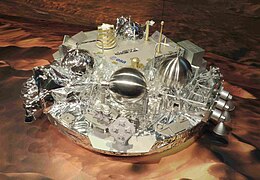Schiaparelli EDM lander

Model of Schiaparelli lander at ESOC (2016)
|
|||||||||||||
| Mission type | Mars lander / technology demonstrator | ||||||||||||
|---|---|---|---|---|---|---|---|---|---|---|---|---|---|
| Operator | ESA · Roscosmos | ||||||||||||
| COSPAR ID | 2016-017A | ||||||||||||
| SATCAT no. | 41388 | ||||||||||||
| Website | ESA Mission WebSite | ||||||||||||
| Mission duration | Planned: 2 to 8 sols (surface stay) Preceded by 3 day coast between separation and entry |
||||||||||||
| Spacecraft properties | |||||||||||||
| Manufacturer | Thales Alenia Space | ||||||||||||
| Launch mass | 577 kg (1,272 lb) | ||||||||||||
| Dimensions | Diameter: 2.4 m (7.9 ft) Height: 1.8 m (5.9 ft) |
||||||||||||
| Start of mission | |||||||||||||
| Launch date | 14 March 2016, 09:31 UTC | ||||||||||||
| Rocket | Proton-M/Briz-M | ||||||||||||
| Launch site | Baikonur Site 200/39 | ||||||||||||
| Contractor | Khrunichev | ||||||||||||
| End of mission | |||||||||||||
| Disposal | Crash-landed | ||||||||||||
| Destroyed | 19 October 2016 | ||||||||||||
| Landing site |
Meridiani Planum, Mars 2°04′S 6°13′W / 2.07°S 6.21°W |
||||||||||||
|
|||||||||||||
|
ExoMars programme
|
|||||||||||||
| Instruments | |
|---|---|
| DREAMS | Dust Characterization, Risk Assessment, and Environment Analyzer on the Martian Surface |
| AMELIA | Atmospheric Mars Entry and Landing Investigation and Analysis |
| COMARS+ | Combined Aerothermal Sensor Package |
| DECA | Descent Camera |
| INRRI | Passive mini retro-reflector |

ESA mission insignia for the ExoMars 2016 launch, featuring the Trace Gas Orbiter (left) and Schiaparelli (right).
Schiaparelli EDM lander [skjapaˈɾɛlːi] was the Entry, Descent and Landing Demonstrator Module (EDM) of the ExoMars programme—a joint mission of the European Space Agency (ESA) and the Russian space agency Roscosmos. It was built in Italy and was intended to test technology for future soft landings on the surface of Mars. It also had a limited but focused science payload that would have measured atmospheric electricity on Mars and local meteorological conditions.
Launched together with the ExoMars Trace Gas Orbiter (TGO) on 14 March 2016, Schiaparelli attempted a landing on 19 October 2016. Telemetry signals from Schiaparelli, monitored in real time by the Giant Metrewave Radio Telescope in India, were lost about one minute from the surface during the final landing stages. On 21 October 2016, NASA released an image by the Mars Reconnaissance Orbiter showing what appears to be the lander's crash site. The telemetry data accumulated by the TGO and ESA's Mars Express orbiters are being used to investigate the failure modes of the landing technology employed.
The Schiaparelli Entry, Descent, and Landing Demonstrator module is named for Giovanni Schiaparelli (1835–1910), an astronomer active in the 19th century who made Mars observations. In particular, he recorded features he called canali in his native Italian. His observations of what translates as channels in English inspired many. The dark streaks on Mars are an albedo feature which is related to dust distribution; these albedo features on Mars slowly change over time, and in the last few decades have been monitored by Mars orbiters. Schiaparelli is famous for making hand-drawn maps of Mars during its 1877 oppositions with Earth with an optical refracting telescope. He was also the first astronomer to determine the relationship between comet debris and yearly meteor showers.
...
Wikipedia
